
This is our large, felt hundred board. (old photograph, hard to see) But here it is set up for skip counting by eights. The counters on it were from our Fun at the Beach felt set.
Math is one of our favorite subjects!
For kindergarten, we used Modern Curriculum Press. I had the Teacher's Edition
to use with Michael's student book, and I must say we enjoyed math very
much that year. MCP was not colorful or flashy, but the pages were interesting
to Michael and we moved through the program very well. I liked the additional
activities suggested by the teacher's manual, and we did most of them. This
kindergarten year was supplemented with homemade shapes and counters for
use on our feltboard.
For first grade, we started the year with Making Math Meaningful (which
was highly recommended to us). Michael liked the program with all of its
manipulatives, but I felt it moved much too slowly for us, was too repetitious
for us, and didn't teach all the concepts we needed for the year - time
being one example. I saw that A Beka had a new math book for first grade.
It was very colorful, more traditional, and I simply felt that it would
more serve our needs, so we switched. When we received the book, I immediately
saw that the the entire first section was material we didn't need to cover.
As we worked through the remaining text, I felt that there was again far
too much repetition. Not only did Michael not want to complete so many problems
each day, I didn't want to devote so much time to math which he already
knew. I started to circle the numbers of the problems I wanted him to complete
each day. By the end of the year, I knew I didn't want to do math this way
the next year.
But something else we did in first grade made a huge difference with Michael's
progression of math. We used the Bible Heroes Skip Count Kids cassette and
learned to skip count. By the end of first grade, Michael could multiply
and divide VERY well - because he could skip count! In conjunction with
skip counting, we used our felt board extensively - especially the side
with the hundred board.
Let me share with you how we used the skip count tape:
I had a piece of yellow posterboard in the house. I cut a strip of it about
3 inches wide and 20 inches long. I placed it horizontally on the table
in front of me. Every two inches I drew a line down, making 10 sections.
I then used a bright blue marker and wrote a number in each section - 1
through 10. Then I put clear contact paper on both sides so that it would
hold up! I set this aside for later.
To start learning to skip count, we made groups of twos with objects. Such
as ten buttons in five groups of two. We would count them by ones and then
by 2's. I first wanted Michael to "see" what we were actually
doing when we skip-counted. We did this with several different types of
items (pencils, paper clips, marbles, etc.). Then we used the hundred board.
We counted the squares by ones over to ten. Then I covered the odd numbers,
and we counted by 2's - "skipping" over the felt-covered numbers
and skip-counting to ten. We touched the numbers we were saying as we skipped
over the counters. We then started to listen to the tape. We didn't listen
to the entire tape... we started with the very first song of 2's. The hundred
board was still set up for skip-counting by two's. We listened to the song
once and then played it again. This time we used our fingers to touch the
numbers on the feltboard as we skipped over to ten. We listened to the song
again and sang along as we skipped our fingers over to ten. We didn't move
on to the number three. We did twos for a few days. And we tested each other
to see how well we knew the song. Our rule was that we couldn't move on
to hear a new song until we both had learned the previous song! Then the
process started all over again with threes. Always grouping something to
"see" first, setting up the hundred board, touching with our fingers,
singing along. Neither Michael nor I heard the songs on that tape until
we were actually ready for the next number. (The six song is my favorite!
<g>)
Now, that yellow strip of paper. I started Michael off with small multiplication
problems. I might give him 3 x 2. He would have the yellow number strip
in front of him. He had a choice now. He could sing his three song and touch
the numbers over to the number two. Or he could sing his two song and touch
over to the number three. It didn't take him very long to figure out that
2x3 is the same as 3x2 and you get the number quicker if you sing the song
for the highest number! To put this another way, he would start to sing
"3 (touch number one), 6 (touch number 2)" and that was his answer
- 6! For 7 x 8, he would sing his eight song (largest number) and touch
over to the number 7. "8 (touch 1), 16 (touch 2), 24 (touch 3), 32
(touch 4), 40 (touch 5) Lord, I'll do what you tell me to! 48 (touch 6),
56 (touch 7)" and that was his answer on number 7 ... 56! When I first
gave him multiplying with two digits, I made columns for the numbers on
his paper and simply showed him how each additional multiplier moved over.
I didn't make a big deal out of it, and he skip-counted everything into
position.
It took us several months to learn all the songs, but we learned them utilizing
all three learning techniques - see, touch, hear - and he has never forgotten
these songs. As time goes by he gets more and more weary of singing them!
He's remembering more facts all the time. And since he has seen the felt
multiplication overlay I made for the hundred board - and that there are
actually very few facts to be memorized, he is more motivated to stop singing
and just remember them. I want to say that I also agree with counting on
fingers! Michael still does it - probably because I took his yellow strip
away a long time ago. He uses his fingers like he used to use that yellow
strip. I always tell him he ever needs to, he can
My web page about felt boards tells about our hundred board.

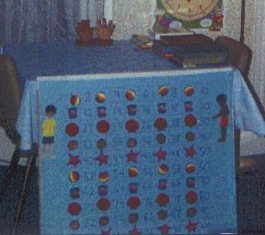
Another poor photo, but you can get an idea of the size of the board. Here
it is set up for skip counting by twos. Two of the children from the Fun
at the Beach set are along the sides.
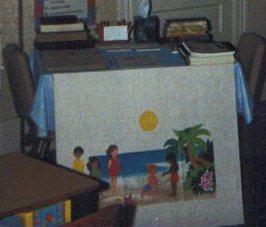
The other side of the same board is where we generally used our Fun at the
Beach figures.
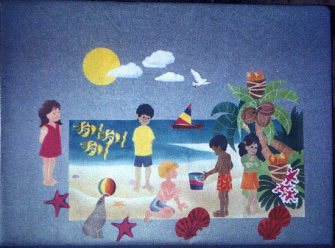
Ahhh, what memories!! Fun at the Beach!
I used to make up math stories for Michael to go along with the setting
for the Fun at the Beach set. We loved reading The Boxcar Children in first
grade (I read them to Michael), and Michael named all the children in the
set after the Boxcar Children - Henry, Violet, Jessie, and Benny! We used
a dog from another felt set to be Watch. The boy with the bucket is Jimmy
- a boy who lived on the island. Here is an example of one of the math stories
which I see matches the photo above:
The Boxcar Children have come to Jamaica for a vacation. They have made
a new friend; his name is Jimmy. Watch has come with the children and has
had fun this morning playing on the beach. Benny and Jimmy have been making
sand castles, and Henry, Violet, and Jessie have been looking for seashells.
After a while, Benny notices Watch is gone! Where could he be? Will you
find Watch for the children? Talk with Jimmy for your first clue.
Jimmy: Answer these two math problems and I'll give you a clue! What is
6 x 4? What is 9 x 9? ......... Great! I saw Watch to the East by the birds
in the bushes.
Birds: Chirp, chirp. If you can tell us the answer to a math problem, we'll
tell you where we saw Watch. What is 43 worms minus 36 worms? ... .....Super!
Watch went Southwest to the clams. We saw them nip at his nose!
Clams: Hello Michael! Add 467 and 294. The correct answer will get you your
next clue! ........ Incredible! We were just playing when we nipped Watch's
nose. He yelped a little and headed Northwest to the ones having school.
Fish (a school of them out in the ocean): We travel in threes, our school
is small, Divide 12 by 3 and then give us a call! ........Wait! We are smart,
we think you are, too, Divide 18 by 9, and we'll give you the clue! ........
Outstanding! Watch was here, he wanted to play, But we love to have school,
we could not stay. Watch went South to play ball.
Seal: Hello! I'm Sammy the seal. Do you want to play ball with me? I love
to bounce my ball on my nose! I skip count while I bounce. You can, too.
Skip count by 6's to 60 ......... Yippee!! Do some more! Skip count by 8's
to 80. .......... Awesome! I'll tell you where I saw Watch. He went East
to the coconut tree. Jessie will help you.
Jessie: Hi Michael! Watch was here. He did the funniest thing! You won't
believe it! I'll tell you if you can answer these questions:
How many cups in a pint?
How many pints in a quart?
How many quarts in a gallon?
How many inches in a foot?
How many feet in a yard?
How many seconds in a minute?
How many minutes in an hour?
Nice job, Michael! You deserve to hear what Watch did. I know you will laugh.
He went North! Yes, up! He climbed this coconut tree and got into the nest
with the birds! It was such a funny sight!
Birds: Chirp, chirp! Tweet, tweet! Watch was here! We couldn't believe it!
If you can solve this math problem, we'll tell you what we know. A boy went
shopping. He had a quarter to spend. At the candy store he bought a peppermint
stick for 10 cents. At the toy store he bought a pinwheel for 5 cents. On
the sidewalk outside he found a quarter! How much money does he have now?
........ Is it more or less than when he started? ........ How much more?
......... Superb! Now we'll tell you what we know. We don't know where Watch
is! There is a bird due West. Maybe he can see Watch!
Bird: Yes! Yes! I see Watch! He is having a good time! Tell me what time
it is right now and I'll tell you where Watch is! ........ Great! He's directly
South! He is sailing on the boat with Grandfather! They are having a good
time!
(The felt piece of the dog was hidden behind the boat out on the water.)
Michael absolutely loved these stories. Sometimes I wrote them out ahead
of time (like this one), other times I made them up as we went along. We
usually sat on the floor in front of the feltboard to do them. Michael would
have a tablet and paper to work out any problems he couldn't mentally figure.
The Fun at the Beach set also includes some shapes (not shown), numbers
and math symbols (not shown), as well as fraction circles.
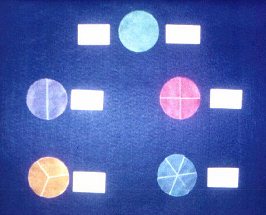 ........
........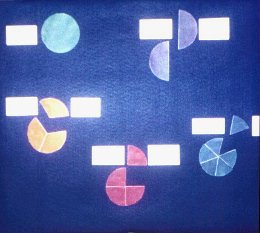
After this first grade year, I started to see that math
was being drawn out over the grades - that we could have easily covered
all of this first grade material in a much shorter period of time, especially
because we are working one on one.
For second grade, we skipped the second grade math texts altogether and
went right to third grade. I purchased A Beka student text for math - 3rd
grade. I didn't use this book by having Michael fill pages out; I used it
simply as a reference to pull information and problems from. It was this
year that I really started to change the way we did math.
Each day, I would give Michael a large sheet of paper on which I had written
just one problem of each: add, subtract, multiply and divide. I tried to
make the problem fairly challenging. I would generally include some review
questions, and a word problem or two. That was it! The bulk of our math
time was then utilized by learning new concepts, playing at the felt board,
or numerous other games/activities. It was during this year that I came
to the realization that elementary school math can be completed in a much
shorter period of time than eight years! By the end of this year, I made
the decision to do math like I do all of our other subjects... in units!
So now we were ready for Michael's third grade. But we were definitely working
at a fourth-fifth grade level by now. I purchased A Beka's 4th grade student
math text, but I barely used it - only as an occasional reference to pull
problems from! (I ended up selling it!) I continued to make homemade math
papers for Michael to complete. But we also started to do math in units.
Before I move on, I'm going to search for some of these homemade math papers
and see if I can get a photo to come out. Be back shortly!! :-)
Ok ... here we go! It's alright that you can't read everything
in these photos. You can at least get an idea as to what I did. <g>
The top page has some simple math functions, identifying plane shapes, making
change for items purchased, and two story problems.
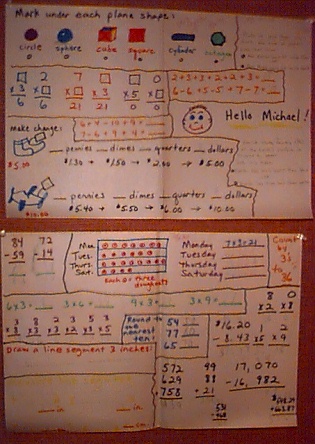
The bottom page has some simple math functions, some measurements,
and a graph utilizing multiplication. These two photos depict papers from
Michael's second grade year (third grade math). Does neatness count? I had
no idea I would ever be showing these to anybody when I made them!!
The above two papers are two of the "early" homemade papers I
made for Michael. These were pieces of large newsprint folded in half. On
the reverse side (you can't see) is another day's problems. As I was looking
at these, I remembered one of the reasons I started homemade papers! Michael
got to a point where he would whimper and start to cry whenever I brought
out the math workbook. I know he felt overwhelmed by all of the problems
on each page. Even if I just circled the ones I wanted him to do, he could
still see them all and it was more than he could handle. So,
I told him he didn't have to do the workbook anymore, and that mommy would
make his papers. Well, he didn't realize that I was just copying the problems
I would have circled in the workbook! :-)
It was a year later that I started with basically one of each problem every
day:
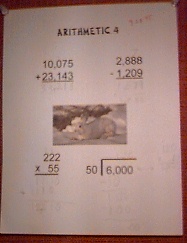 .
.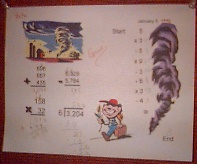 .
.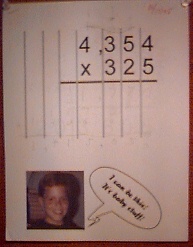
The paper on the far left shows simply four math functions
for the day. The middle paper also has four math problems as well as one
problem utilizing several different math functions within. The last paper
is one of the early papers when Michael was learning to multiply multiple
digits. The paper shows the lines I drew for him to line up his work.
I did use the computer to make many of these papers, but I also simply used
a marker and a plain piece of paper. I must admit though, Michael liked
the papers with the clip art the best. Today we just use notebook paper
and pencils to do most everything.
Back to this "third grade" year (last year). We started the year
by getting a spiral bound notebook. We were going to make our own math reference
book as we went along. I'll talk more about this later.
Each day, after Michael would complete his homemade math paper, we would
work on our unit. Our first unit was a geoboard unit. We had a nice wooden
board and loads of different color rubber bands. It never failed - whenever
I brought this out, Michael suddenly wanted to get real creative and make
designs with the rubber bands. I always let him! <G> Once he had a
few designs out of his system, then we could get on with our lesson. We
used the book Stretch It by Anne Lineham (Teaching Resource Center, 1-800-833-8552),
following the activities they outlined. It was very informative and quite
fun.
Our next unit was Charts and Graphs. We completed Usborne's Charts and Graphs
book, then we came up with our own project. We don't buy the newspaper at
our house. But for one full week, we purchased a newspaper each day. I would
go through each section and read just the headlines of articles to Michael.
He would then say yes or no - depending on whether he felt the article sounded
interesting or not. I would put an "x" by the "yes"
headlines. Once we had determined all the interesting headlines, we would
then cut them out and tape them in an overlapping manner onto a piece of
newsprint. At the end of the week, we listed all of the newspaper categories
(such as world news, local news, sports, weather, health, finance, humor,
advice, recipes, etc.). There were 19 categories total. I would read the
heading, we would determine which category the article belonged under, and
Michael would then make the "fenceposts" (tally marks) under the
proper category. When we had all the numbers added up, we then went to our
software program by Davidson - The Cruncher. What a nice tool for making
charts and graphs. Michael did a great job showing all the topics, keying
in the numbers, and then making a bar graph to show which type of articles
he felt sounded the best. What a laugh when we saw the the top-rated type
of article was - RECIPES!! That's really not a big surprise, Michael loves
to cook! Second was State/Local News, tied for third was Human Interest
and Cartoons. I should add that some of the article headlines intrigued
Michael enough that we always had to read a few of the articles each evening.
About this time, I found a great set of new books in our public library.
The series was entitled - Let's Investigate.
We utilized several of these books for math units. We read Let's Investigate
Statistics while we worked on our newspaper project above.
We then moved to our next unit - Averages. We taped a really neat show from
PBS which showed children the different averages - mean, median and mode.
I don't think I ever had this clear in my mind, and this little show really
helped. Then we went to the library and found Let's Investigate Averages.
We were doing a weather unit at the same time we were doing averages. For
one month, we tried to get the temperature at about the same time every
day. We used the internet for our information - The Weather Channel. We
also jotted down if it rained on that particular day. At the end of the
month, Michael had a list of temperatures and the number of rain days. Once
again, I set him down at The Cruncher and told him to make a chart for me
showing the daily temperatures for the month (June). He did a nice job!
He then computed the mean temperature (76 degrees), the median temperature
(75.5 degrees), and the mode (74 degrees and 76 degrees tied for the mode).
The number of days in which rain occurred was 13.
I won't go into detail with every unit and everything we did, but here are
some of the remaining units we did last year:
A BIG geometry unit! We worked through Let's Investigate Quadrilaterals
and Let's Investigate Angles. Plus, we utilized several other books
we had available.
I see from my notes we worked through Let's Investigate Numbers as
well. In this book we worked with a number line and positive and negative
numbers.
From here we moved into a Fraction Unit - which we carried over into this
year.
I see I have one more book listed that we worked through after we started
the fraction unit - just as a side unit -- Let's Investigate Area &
Volume.
I mentioned that we had a spiral-bound notebook which we were utilizing
to make our own math review book. I have it in front of me, and I will just
try to list some of the things which we put in here:
--It starts with some simple information - labeling the parts of math problems
(addend, subtrahend, product, quotient, etc.).
--Michael put the answers on a multiplication table which I had copied into
the book.
--We show even and odd numbers.
--Then there are a lot of measures - time measures (60 seconds = 1 minute,
etc.), length measures, weight measures, capacity measures, metric prefixes,
and temperatures.
--We have a page with Roman Numerals and the rules for using/reading them.
--Prime Numbers and Composite Numbers.
--A number line showing Negative & Positive Numbers.
--A page for Averages!
--A page for Charts and Graphs (tally marks, pie charts, bar graphs/charts).
--Binary Numbers explained.
--A penny doubled each day -- the chart which shows what will happen!
--Many pages of Geometric Lines/Angles/Drawings and Terms.
--Pages showing Area and Perimeter.
--We stapled in some pages from our Geoboard activities.
--We have envelopes glued in here which hold our construction paper manipulatives
we made while learning about angles.
--The book ends with what we learned about fractions last year.
We had a very busy math year last year - and it was fun! By only asking
Michael to complete "Mom's Homemade Math Paper" each day, we had
time for delving into many more math projects.
Now, you probably wonder what we did THIS year! :-)
Well, mom's homemade math papers still work very well! And we started this
year by continuing to work with fractions.
But then I found a book which we just had to start working through! I was
browsing Border's Book Store (drooling on the books was more like it!),
and I found a series of books from The Princeton Review. They are the Junior
Smart books. The book for math is Math Smart Junior, Math You'll Understand.
This is on the cover of the book: "Learn decimals from making lemonade.
Save a kitten with the Pythagorean theorem." The book is for grade
6-8, but we have certainly enjoyed working in this book! The math is presented
around a story of three children who are trying to beat the heat one summer.
The story is entertaining and humorous, the math tips are really helpful.
Like this one for when you are dividing fractions - "When it's time
to divide, don't ask why -- just flip it over and multiply." Very easy!
Of course, they do show us why this works as well. If you've read my software
page, you know that they are coming out very soon (if not already!) with
an algebra cd for the computer. I will definitely want to see that! (I actually
bought ALL the books in the Junior Smart series. We're also working through
the Geography Smart Junior, too! Very cool! Check your library for these!)
I need to wrap this math page up! The big question is - Will I ever use
a textbook? Well .... yes! As a matter of fact, we have started working
through Ray's Arithmetic here at the end of this year, and I do intend to
use it as my primary math source for next year.
Why Ray's? Well, I've been pulling my story problems from an old Harvey's
Practical Arithmetic elementary math book for about two years now. Problems
like this:
"A salesman sells three bills of goods. The first amounts to $245;
the second to three times as much; and the third to as much as the other
two. What is the amount of the three bills?" We call these types of
math problems "brain busters" because Michael has to really read
for understanding, and then really think about what he is calculating.
Here's another: "A seamstress earns $12 a week and spends $4 a week
for board and $1 a week for other expenses. In how many weeks will she save
$35?"
This Harvey's book also has some standard math problems in it, but I liked
it so well, that I really started to think hard about using Ray's Arithmetic.
Then I happened to talk with a woman who was using Ray's Arithmetic with
her son. Up until sixth grade, her son had been working in a fairly traditional
type of workbook for math. He was tested at the end of fifth grade and scored
at about the 50th percentile for math. She then switched to Ray's. At the
end of sixth grade, he was again tested. His math percentile jumped into
the high 90's! She was astonished! After just one year of Ray's Arithmetic!
She said that she and her son worked the math TOGETHER. I think that was
very important. She said it was a real challenge for them to work some of
the problems. Sometimes, after he would go to bed at night, she would sit
down and continue trying to work something out. <g> She indicated
they would congratulate each other when they realized they had a concept
mastered. That might make the math sound hard, and for them - it was! It
may not be so difficult for someone else. But they didn't give up! Her son
said the testing at the end of sixth grade was easy compared to what he
and mom do.
I looked over her little Ray's book (they are small books), and I knew this
was what I wanted for us. It was a natural for us after working from the
old Harvey's Practical Arithmetic. I bought the Ray's New Practical Arithmetic.
It is for grades 5 and 6. I like that the math is mostly presented in real
life situations (although not modern day situations - we think that makes
it more fun!). You don't just see numbers on a page to compute - there are
people and objects and things happening behind those numbers.
After sharing all this with a friend of mine, she switched to Ray's for
her son in sixth grade. They used it this past year and she recently told
me they loved it! She said math made so much more sense to her son because
he could see it being used "real life situations" - not just manipulating
numbers.
My goal is to complete the Ray's Practical Math next year and then move
on to Ray's Higher Arithmetic. I would like to have elementary math completed
within the next two years.
I am trying to think ahead. Michael has a very strong entrepreneurial spirit.
He wants to own a business someday. A four-year college will probably not
be for us, but our two-year technical college may be a good start for business
management classes. If I guide his math into more business-oriented math,
I believe it will be beneficial for him. I feel the Ray's Arithmetic will
be a big plus for us in this direction.
Well, that's enough for math! I'm sure there are some things I forgot. (Like
the checkbooks we did with play money - and Michael used some of his money
to buy a liver and onions dinner!) But we've always had fun with math. Why
should our other subjects be hands-on and fun, but not math?
I hope you were able to gather an idea or two out of all this! :-)
Oh, I almost forgot! Fun at the Beach felt set ... I purchased mine from
The Sycamore Tree, 2179 Meyer Place Costa Mesa, CA 92627. 714-650-4466.
Check your other catalogs for it as well.
And I forgot this, too! Bible Heroes Skip Count Tape. I purchased mine from
Sing 'n Learn, 2626 Club Meadow, Garland, TX 75043-1102. 1-800-460-1973
or, in the Dallas area, 972-278-1973. Website at www.singnlearn.com
Go back to see what else I have on my web pages...![]()
Return to our home page...![]()